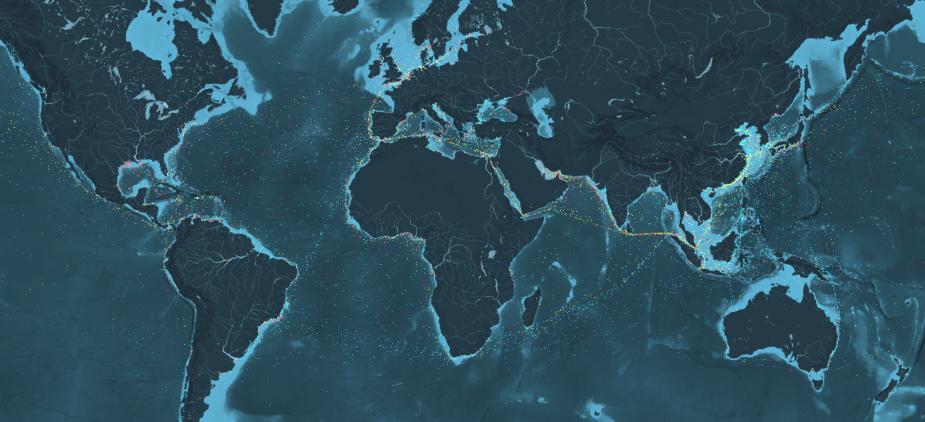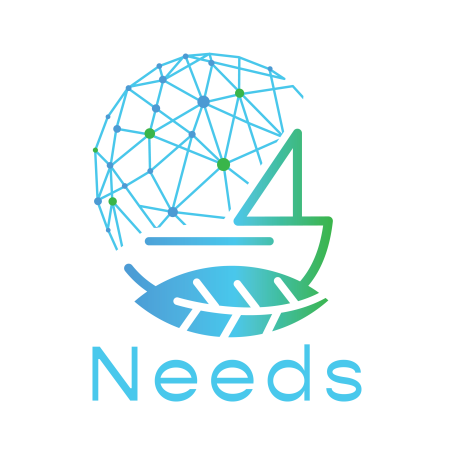

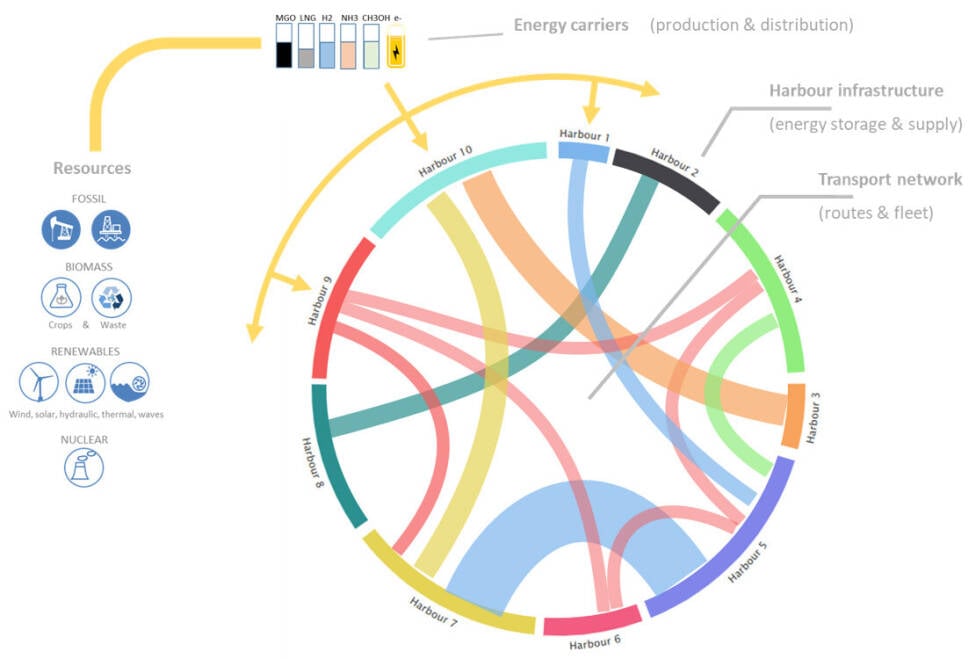
The different components of the NEEDS framework.









October 2024, no. 141
NEEDS - Techno-economic scenario simulation framework

waterborne.eu/projects

needs.application.marin.nl/

More info
The NEEDS project has received funding from the European Union’s Horizon 2020 research and innovation programme under grant agreement No 101056938.

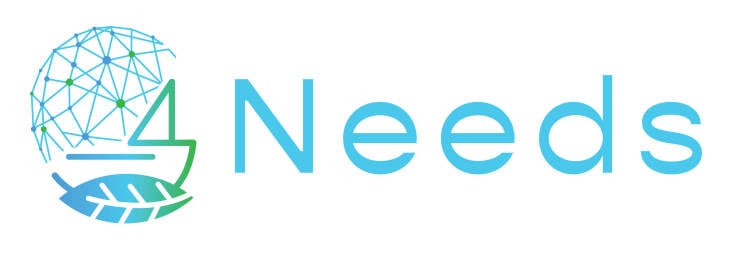
Create a MARIN account to stay updated





Report
Two NEEDS test cases performed


Greece’s waterborne transport network with bunkering needs in one of the scenarios.
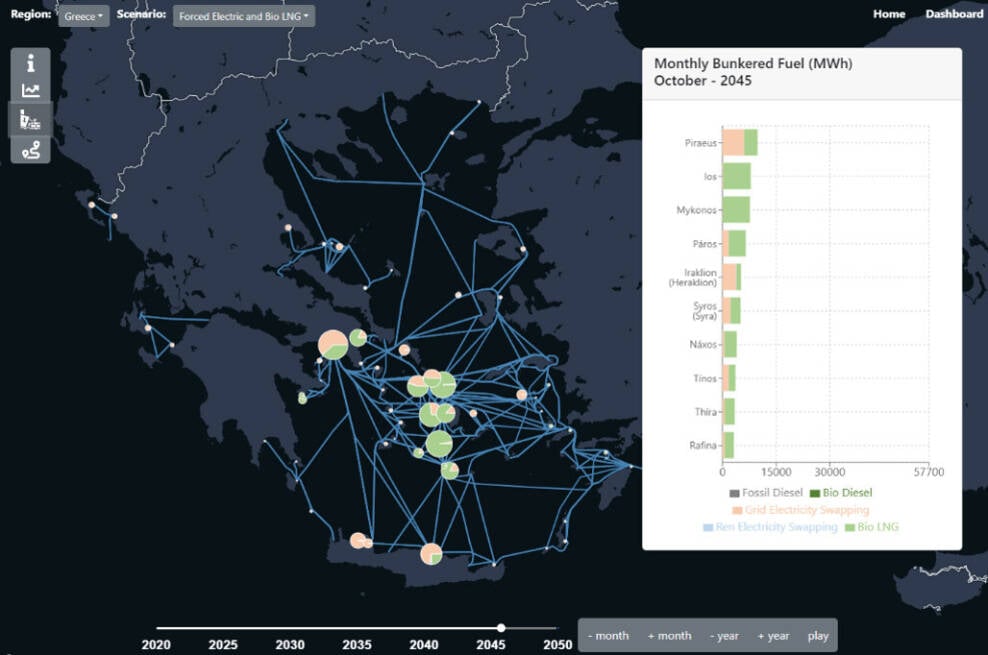
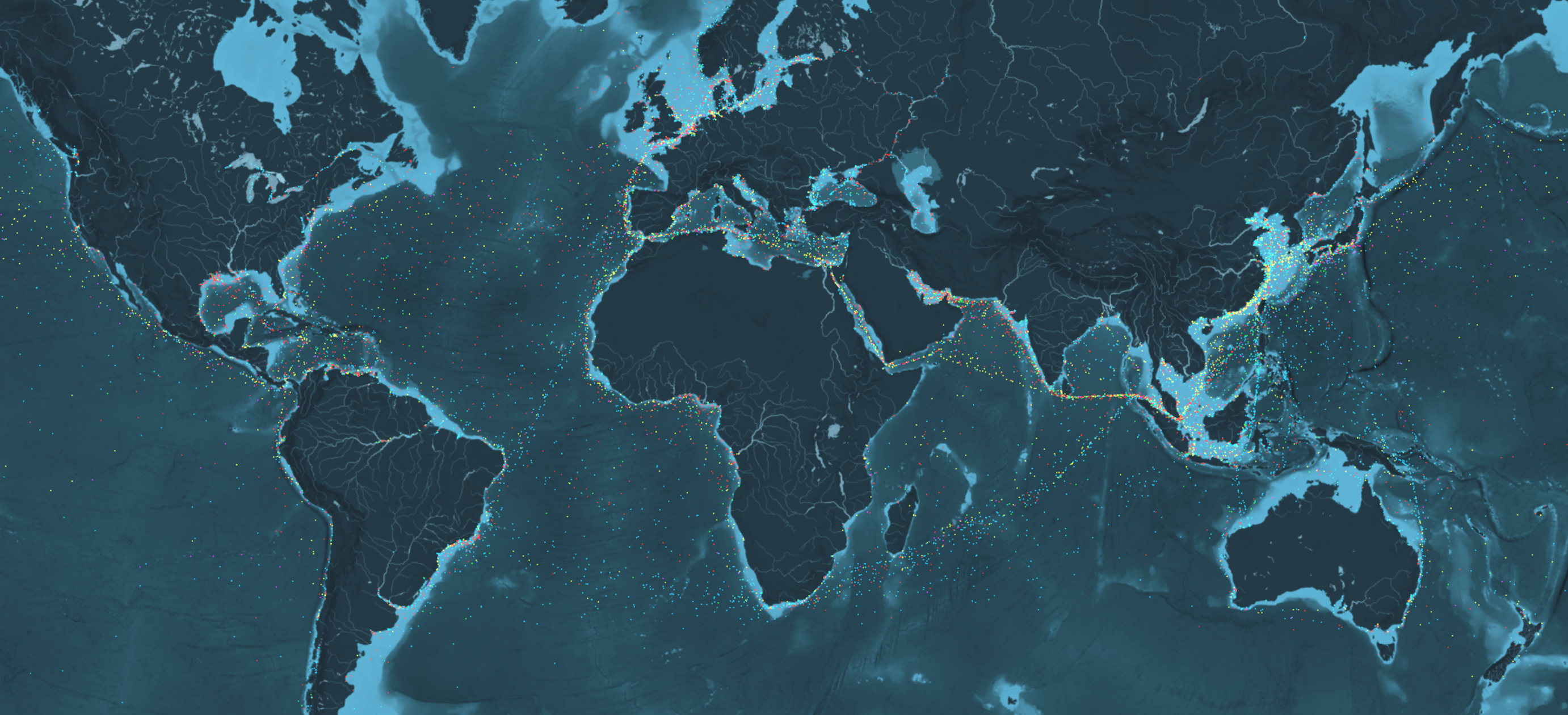
The simulations always start with a benchmark case, mainly the current situation. Such a step is needed to model the complete network and the ship operations at regional and fleet level. The benchmark is also used to check the robustness of the modelling, as well as the accuracy of the simulated transport capacity, energy use, costs or emission levels.
Defining operational strategies
When validated, workshops on alternative scenarios can start, which will consist of implementing a refit strategy, the supply of alternative energy or implementing new vessels or new operational conditions. These steps correspond with defining the strategy at a regional or fleet level and detail its implementation. The simulations are then run to check if the scenario can realistically be implemented or not.
The global transportation sector (road-air-sea) is an important contributor to greenhouse gas emissions for our blue planet, emitting 25% of the total GHG emissions. Although the shipping industry itself only accounts for 3% of global emissions, while moving close to 90% of goods worldwide, it belongs to the hard-to-abate category and is expected to increase when no action is taken.
For those implementing sustainable solutions, there are major challenges ahead because the assets, ships and harbour infrastructures, require huge investments and are used for a long time. And to date, they cannot rely on an energy sector that waits for clear and massive demand before producing, making the risk of being a frontrunner even larger. If you go alone, you can go fast, but you don’t necessarily go anywhere…
In order to support the energy, harbour and shipping sector, as well as the authorities working together on realistic scenarios, MARIN and European partners within the EU Horizon project, created the NEEDS techno-economic simulation framework.
Interested? Contact us to discuss your options
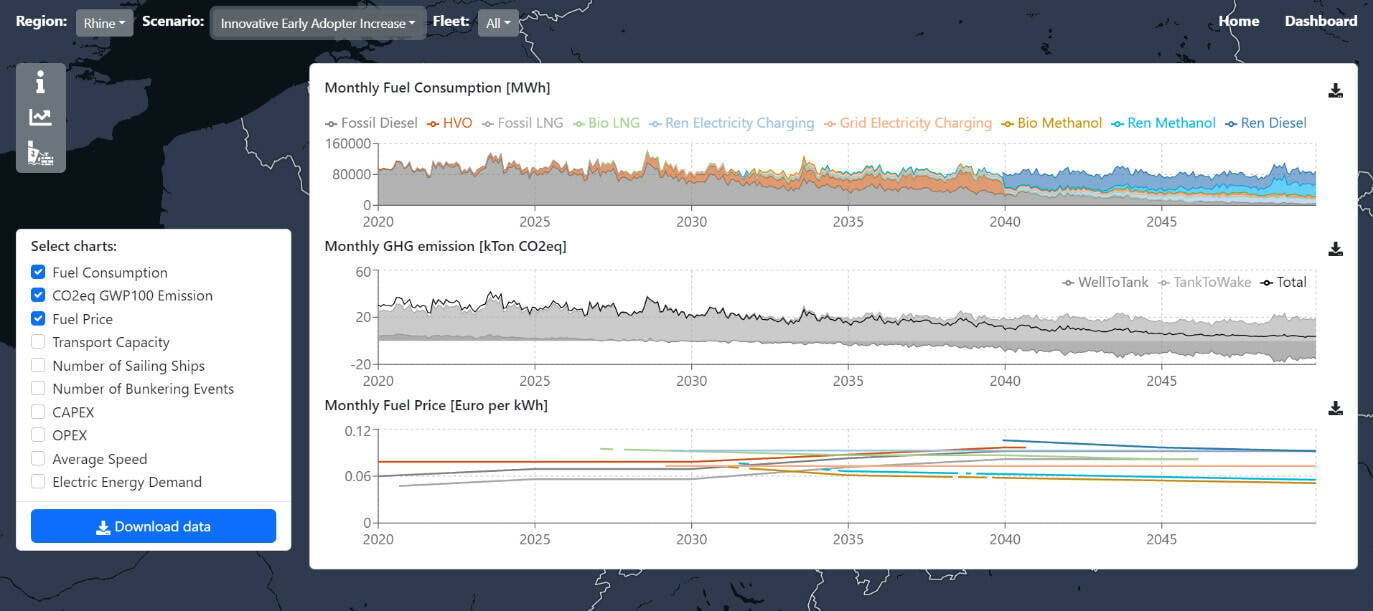
Simulation of the evolution of used energy and effect on emission levels.
The economical side is covered by calculating operational costs (OPEX) and capital expenditure (CAPEX), from which a Total Cost of Ownership (TCO) is derived.
Consequences of upcoming regulations, such as the EU Emissions Trading System, can be implemented to study their effect on the TCO and the possible need for a refit that might become more interesting compared to keeping the same technology using fossil fuels.
So far, two test cases were run within the Horizon Europe project, namely the transition pathways for the inland navigation of the Rhine, and the maritime transport network of Greece. Current studies are now covering shortsea shipping routes in the North Sea and Baltic.
Implementing individual solutions for each stakeholder can also lead to unsuccessful plans. While technical solutions can exist individually for the production of renewable energy, sustainable alternative energy carriers, storage & supply, and alternative powers and zero emission ships, the complexity of the interdependency of each stakeholder makes the transition pathway complex and risky. Their deployment does not always follow the same agenda.
Identifying the challenges
The NEEDS framework focuses on defining the needs, identifying the challenges and coordinating implementation strategies, while predicting the investments. The scenario simulations bring together each stakeholder in a transport chain over a period of 30 years. For example:
Renewable energy production and its transformation in given energy carriers
Energy infrastructure, mostly in harbours: energy storage and supply/bunkering
Ships, with their characteristics, operational profile, transport capacity, power systems and routes
Additional variables such as climate (waves, wind, current, water depth) are also mapped and time dependant on the area of operations, as they will play a role in the energy use and operational speed, or energy supply in the case of wind propulsion.



The NEEDS project has received funding from the European Union’s Horizon 2020 research and innovation programme under grant agreement No 101056938.

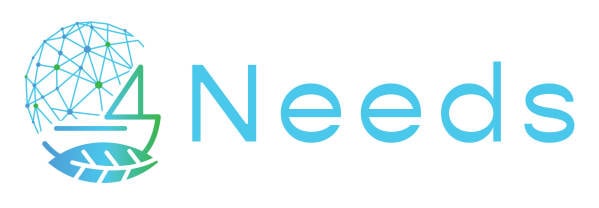
NEEDS - Techno-economic scenario simulation framework

October 2024, no. 141
The economical side is covered by calculating operational costs (OPEX) and capital expenditure (CAPEX), from which a Total Cost of Ownership (TCO) is derived.
Consequences of upcoming regulations, such as the EU Emissions Trading System, can be implemented to study their effect on the TCO and the possible need for a refit that might become more interesting compared to keeping the same technology using fossil fuels.
So far, two test cases were run within the Horizon Europe project, namely the transition pathways for the inland navigation of the Rhine, and the maritime transport network of Greece. Current studies are now covering shortsea shipping routes in the North Sea and Baltic.
Greece’s waterborne transport network with bunkering needs in one of the scenarios.

The global transportation sector (road-air-sea) is an important contributor to greenhouse gas emissions for our blue planet, emitting 25% of the total GHG emissions. Although the shipping industry itself only accounts for 3% of global emissions, while moving close to 90% of goods worldwide, it belongs to the hard-to-abate category and is expected to increase when no action is taken.
For those implementing sustainable solutions, there are major challenges ahead because the assets, ships and harbour infrastructures, require huge investments and are used for a long time. And to date, they cannot rely on an energy sector that waits for clear and massive demand before producing, making the risk of being a frontrunner even larger. If you go alone, you can go fast, but you don’t necessarily go anywhere…
waterborne.eu/projects

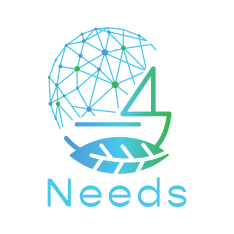
needs.application.marin.nl/

More info

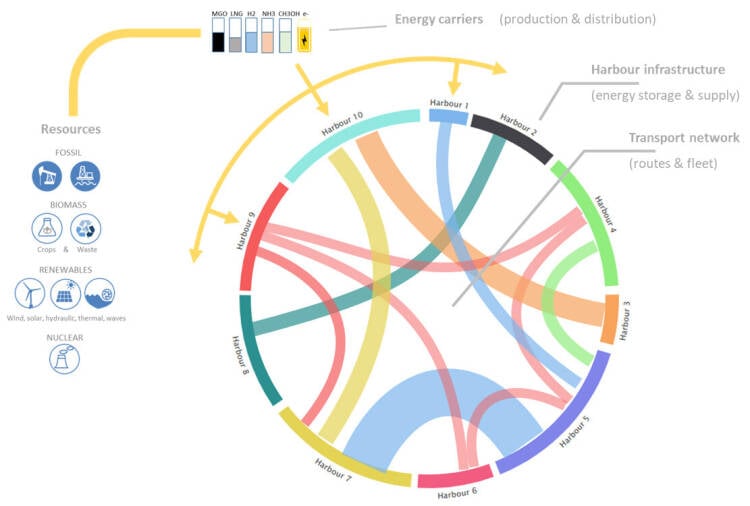
The different components of the NEEDS framework.
Sea the Future.
Interested? Contact us to discuss your options
The simulations always start with a benchmark case, mainly the current situation. Such a step is needed to model the complete network and the ship operations at regional and fleet level. The benchmark is also used to check the robustness of the modelling, as well as the accuracy of the simulated transport capacity, energy use, costs or emission levels.
Defining operational strategies
When validated, workshops on alternative scenarios can start, which will consist of implementing a refit strategy, the supply of alternative energy or implementing new vessels or new operational conditions. These steps correspond with defining the strategy at a regional or fleet level and detail its implementation. The simulations are then run to check if the scenario can realistically be implemented or not.
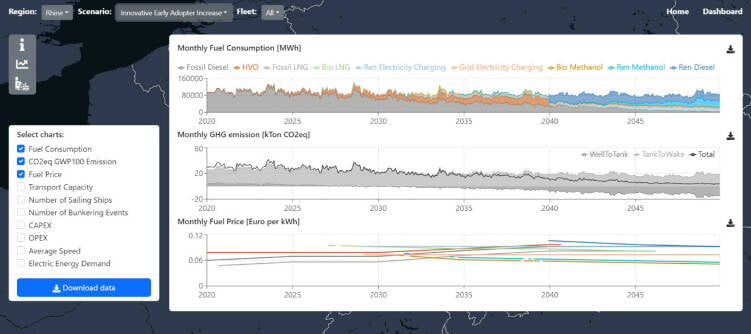
Simulation of the evolution of used energy and effect on emission levels.
Implementing individual solutions for each stakeholder can also lead to unsuccessful plans. While technical solutions can exist individually for the production of renewable energy, sustainable alternative energy carriers, storage & supply, and alternative powers and zero emission ships, the complexity of the interdependency of each stakeholder makes the transition pathway complex and risky. Their deployment does not always follow the same agenda.
Identifying the challenges
The NEEDS framework focuses on defining the needs, identifying the challenges and coordinating implementation strategies, while predicting the investments. The scenario simulations bring together each stakeholder in a transport chain over a period of 30 years. For example:
Renewable energy production and its transformation in given energy carriers
Energy infrastructure, mostly in harbours: energy storage and supply/bunkering
Ships, with their characteristics, operational profile, transport capacity, power systems and routes
Additional variables such as climate (waves, wind, current, water depth) are also mapped and time dependant on the area of operations, as they will play a role in the energy use and operational speed, or energy supply in the case of wind propulsion.
Two NEEDS test cases performed
In order to support the energy, harbour and shipping sector, as well as the authorities working together on realistic scenarios, MARIN and European partners within the EU Horizon project, created the NEEDS techno-economic simulation framework.
Create a MARIN account to stay updated





Report
